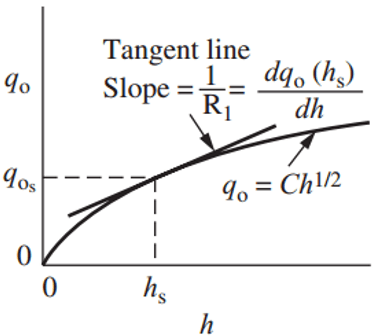This set of Process Control Multiple Choice Questions & Answers (MCQs) focuses on “Linearization”.
1. Which of the following system is linear in nature?
a) Liquid level system
b) Spring dashpot
c) Sinusoidal wave function
d) 1D heat transfer
View Answer
Explanation: Spring dashpot is second order system. Sinusoidal due to its sine nature is non – linear. 1D heat transfer is also not linear. Hence liquid level system is definitely linear in nature.
2. Which of the following is correct for time constant for a liquid level tank?
a) Time constant is a function of tank cross section area and resistance of the flow through the valve
b) Time constant is not a function of tank cross section area and resistance of the flow through the valve
c) Time constant is the summation of tank cross section area and resistance of the flow through the valve
d) Time constant is independent of tank cross section area
View Answer
Explanation: For a liquid level tank system, the time constant is T = AR where A is the cross – sectional area of the liquid tank and R is the resistance of fluid flow. Thus, it is evident that the time constant is a function of tank cross section area and resistance of the flow through the valve.
3. Which of the followings has a nonlinearized model qin – Ch1/2 = A \(\frac {dh}{dt}\) ?
a) Mixing system
b) Heating system
c) Thermometer system
d) Liquid level system
View Answer
Explanation: For a liquid level system,
qin – qout = A \(\frac {dh}{dt}\) ……..(i)
Now if the flow out of the tank follows a square root relationship, qout = Ch1/2, where C is a constant.
Thus, equation (i) becomes,
qin – Ch1/2 = A \(\frac {dh}{dt}\)
4. Which of the following option is correct for the resistance of a non – linear liquid level system?
a) The resistance is linear
b) The resistance is non linear
c) The resistance never has a finite value
d) The resistance may have a negative value
View Answer
Explanation: The expression for resistance of a non – linear liquid level system is given
R = 2\(\frac {h^{0.5}}{C}\)
Thus, the resistance is non – linear in nature.
5. Which of the following option is correct regarding a non – linear liquid level tank?
a) The resistance is the reciprocal of the slope of the tangent line passing through the point (qo s, hs)
b) The resistance is the slope of the tangent line passing through the point (qo s, hs)
c) The slope of the tangent line passing through the point (qo s, hs) is independent of the resistance
d) The resistance is the reciprocal of the slope of the tangent line passing through the point (qo s, hs) and the product of the cross – section area of the liquid tank
View Answer
Explanation: From the graph of q0 vs h, it is evident that the resistance is the reciprocal of the slope of the tangent line passing through the point (qo s, hs).

6. What will the value of the steady state flow rate from a liquid level tank for a steady state height of 4 ft in the tank with tank constant value 8 cfm / ft1/2?
a) 10 cfm
b) 16 cfm
c) 20 cfm
d) 24 cfm
View Answer
Explanation: We know for a liquid level tank, the steady state flow rate is given by,
qos = C × hs1/2 where C is the constant of liquid level system and hs is the steady state height.
So, qos = 8 × 41/2 cfm
= 16 cfm
7. Which of the following statement is correct for a nonlinear system?
a) The response to a step change of magnitude A is not equal to A times the unit step response
b) The response to a step change of magnitude A is equal to A times the unit step response
c) The response to a sum of inputs is equal to a sum of the individual responses
d) The magnitude and dynamic character of the step response are independent on the initial steady – state operating conditions
View Answer
Explanation: For a linear system, a step change of magnitude A is equal to A times the unit step response. For a nonlinear system, the response cannot be equal to the magnitude of the input.
Sanfoundry Global Education & Learning Series – Process Control.
To practice all areas of Process Control, here is complete set of Multiple Choice Questions and Answers.
If you find a mistake in question / option / answer, kindly take a screenshot and email to [email protected]
